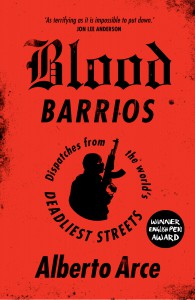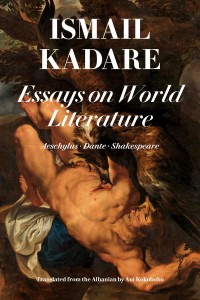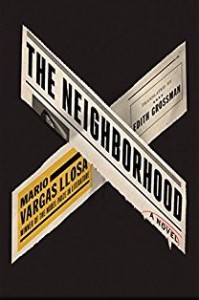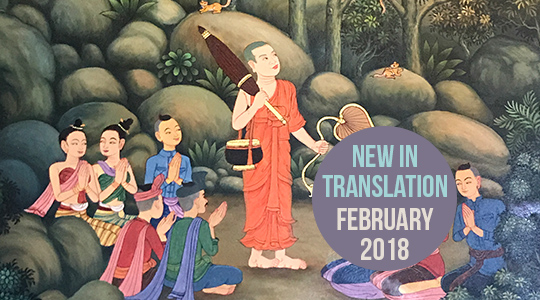For many of us, this month will be either the coldest or the hottest of the year; luckily, the books we’re focusing on this February are resilient and long-lasting—featuring new titles from Albania all the way to Latin and Central America.

Blood Barrios by Alberto Arce, translated from the Spanish by John Washington and Daniela Ugaz, Zed Books
Reviewed by Jessie Stoolman, Editor-at-Large for Tunisia
Blood Barrios, Alberto Arce’s account of his diverse experiences as the only foreign journalist inside Honduras between 2012 and 2014, gives a platform to voices inside this small Central American country that are seldom heard. From deep within the Mosquitia jungle, where Arce investigated possible American involvement in massacring innocent civilians, to an overcrowded prison farm where over 350 people died in a fire, he makes “[t]he privileges of a foreigner” in Honduras “his obligations,” asking questions that others cannot.
Intimately aware of the dangerous apathy that arises from regurgitating statistics, Arce is careful to use these numbers sparingly, as they are “flashy, but don’t really impact anyone, not even you, reader.” The heightened violence in Honduras, which stems from a weak state embroiled in the drug trade, prompts Arce to compare it to regions where wars have officially been declared, such as Iraq and Afghanistan. In one example, he notes that in San Pedro Sula (one of Honduras’ largest cities) “there are more violent deaths than in Baghdad or Kabul.” With these macro-observations, Arce forces the reader to recognize the power of narrative, declaring that Honduras “very well could be [Iraq], if that’s how I decided to tell it, or if the media agenda demanded it,” because ultimately, “[i]t’s a matter of focus – fluctuating according to the dictates of decisions that aren’t made either in Baghdad or Tegucigalpa.”
However, the bulk of Arce’s book covers stories of individuals, from ordinary citizens, such as Wilfredo, the food distributor whose son was killed at a military checkpoint without reason, to high-level government officials, including El Tigre Bonilla, the infamous Police Commissioner accused of establishing death squads in Honduras. Arce thus resists the trap that other journalists, NGOs, and history books fall into, using “ready-made catchphrases and generalizations that allow us to feel that we can understand the situation of Honduras and other Central American countries in a thousand words.” Interspersing investigative vignettes with drawings of scenes from the book by the Honduran artist, Germán Andino, Arce weaves a layered map of stories that prevents any one narrative from dominating.
Given that Arce repeatedly reveals the vast extent of police corruption in Honduras, Commissioner Bonilla’s claim that “[w]e live in a culture of simulacrum, in which nothing is what it appears and the reigning vision has no relation to the real world,” rings darkly ironic throughout the book. In “Four Boards Strapped to the Back,” Arce highlights how even the press in Honduras appears to be engaging in the creation of this surreal “reigning vision.”
As is Arce’s style, he begins on the micro-level, recounting the life and death of Santos Arita, a police officer killed by two teenagers, Edwin and Eduardo, during a routine traffic stop. In what appears to be a “public lynching,” Eduardo was killed and Edwin survived “by pure accident, mistake” after being subjected to torture in police custody. The prosecutor in the case argues that this murder is “part of a policy of ‘social cleansing’ that would not be possible without the collaboration—of either enthusiasm or omission—from the local press, [as] no government official or police officer was asked to comment, defend, or explain themselves, because no journalist asked them to.”
Unlike the journalists who failed to adequately investigate this and other grave oversteps in police power, Arce is quick to note how journalism can fail those most intimately effected by such a tragedy. The son of the slain officer, Joaquín, makes his disillusionment clear to Arces: “Just when the shame of the journalist who reported a story, and then quickly disengaged, started to dissipate into the past, Joaquín charged at me again. ‘Hi Alberto. I see that in the end I was right. No one has helped me.’”
For anyone, particularly a foreign journalist, who as Arce openly admits has “no official training in his line of work,” providing a multidimensional picture of a country suffering “a forgotten and low-intensity war” may seem like an impossible task. Nonetheless, by mixing shocking statistics about Honduras with investigative pieces following those affected by and affecting the current situation, Arce provides a captivating and comprehensive introduction to this region, too often ignored by the outside world.

Essays on World Literature: Aeschylus, Dante, Shakespeare by Ismail Kadare, translated from the Albanian by Ani Kokobobo, Restless Books
Reviewed by Barbara Halla, Editor-at-Large for Albania
Featured in our Winter 2018 Issue
There is an expression that Albanians are keen on using whenever confronted with the prospect of an unpleasant activity: Më qani me llahinga. It does not have an English equivalent, but the spirit of the phrase is this: “What I am about to do is so soul-wrenching that professional mourners should be booked to cry for me, as a physical manifestation of my pain.” Professional mourning is now a thing of the past, at least in Albania. Nevertheless, the practice of hiring outsiders, usually women, to cry at someone’s funeral was for centuries a cornerstone of Balkan burial rites. It is one of the many traditions that Kadare uses as inspiration for his literary analysis in Essays in World Literature: Aeschylus, Dante, and Shakespeare, translated by Ani Kokobobo and published by Restless Books.
The essays contained in this collection were published in Albania, independently of each other, between 1985 and 2006. More than simply analysis, the three essays are investigations into the roots and routes that brought Aeschylus, Dante, and Shakespeare into the Albanian consciousness. They also trace how the Albanian experience can enrich the reader’s understanding of Aeschylus’s tragedies, Dante’s Hell, and Hamlet’s universal appeal.
“Aeschylus, the Lost” is the collection’s strongest piece. Here, Kadare laments the fate of Aeschylus’s body of work—the vast majority lost to time and only seven plays remaining. With no biographical context (and a scant literary one), a reader can struggle to understand how a society that worshipped comedy can give birth to tragedy, or what mechanisms guided Aeschylus’s understanding of justice and retribution. Kadare offers his own blueprints to aid readers fill this vacuum: look, he says, at the burial rites in the Balkans. What are professional mourners if not the precursors to the Greek chorus? If you want to understand what pushed Orestes to matricide one need only read the Kanun that still regulates—over any state law—the remote villages of Northern Albania. In its bylaws the reader can see how the rules of transitional justice that guided Orestes’s decisions in The Oresteia continue to haunt Albanian families to this day. For “spilled blood must be met with spilled blood.”
The ties to Albanian traditions that give “Aeschylus, the Lost” its literary vigor falter when used to approach Dante and Shakespeare. The ensuing essays provide a number of entertaining anecdotes around the historical events that brought The Divine Comedy and Hamlet to Albania in the early twentieth century, but their focus is disjointed. Equating Dante’s Hell with fascist and Communist occupation of Albania is obvious (perhaps too much so) and might leave readers feeling patronized. In “Hamlet, the Difficult Prince,” Kadare tries to account for Hamlet’s universal appeal, starting by investigating its mythological roots (both Greek and Scandinavian) and even comparing the rituals and dilemmas surrounding Hamlet’s mission to the lives of Albanians involved in blood feuds. What he fails to mention is that Hamlet’s universality lies partly elsewhere, namely in forcing the reader to confront their mortality and the fact that we often remain in life by choice.
Kadare’s introduction to this book gives us a clue to understanding these discrepancies. In the end, these essays are fragments of a writer’s diary, the outcome of evanescent inspiration rather than premeditation. Nevertheless, Kadare’s erudition and passion for his subject matter are on full display. Even those that know him solely through his fiction should not be discouraged. Kadare cannot shake his mantel as a fiction writer, often treating his subjects as characters in a novel, supplying Aeschylus with intent and unexpectedly placing Hamlet in direct dialogue with a young Albanian man whose quest for blood revenge is guided by principles very different from Hamlet’s own.
Some suspension of disbelief is required, a knowledge of Greek mythology is useful, but nonetheless this collection makes for an illuminating reading. Kadare is right to say that academic study of Greek myths has neglected some more obvious sources, providing his own interpretations in response. Thankfully, Kokobobo’s English translation captures the nuances of Kadare’s writing, carefully manoeuvring around Albanian colloquialisms and untranslatable verb tenses, aided in part by Kadare’s own scrupulous tendencies.

The Neighborhood by Mario Vargas Llosa, translated from the Spanish by Edith Grossman, Farrar, Straus and Giroux.
Reviewed by Lara Norgaard, Editor-at-Large for Brazil
Constructed from the gritty mystery of unsolved crimes and the hushed drama of illicit affairs, intrigue is often what glues together the mosaic narratives of Nobel Prize-winning Peruvian author Mario Vargas Llosa. His novels combine vibrant characters with real-world settings, giving readers intimate and complex portraits of Latin American political and social worlds.
Vargas Llosa’s latest novel, Cinco Esquinas (The Neighborhood), translated by Edith Grossman and published by Farrar, Straus and Giroux, has a premise that suggests readers will delve into yet another intrigue. The story is a thriller set in Lima in the 1990s with the backdrop of the Fujimori dictatorship and Peru’s guerilla terrorism. While Enrique Cardenas, a member of the city’s business elite, finds the dark sides of his private life exposed, we discover that the same yellow newspaper that works to destroy reputations has its own dirty secrets—ones that end in bloodshed.
This pseudo-hardboiled detective novel recalls the search for a culprit in Vargas Llosa’s Who Killed Palomino Molero? (1987). Its multifaceted take on urban Lima—complete with intrepid journalists, failed artists, intense wealth disparities, and authoritarian control—cannot but carry the memory of one of the author’s early novels, Conversation in the Cathedral (1975), set in the same city decades before, under the Odría dictatorship of the 1950s. And yet The Neighborhood carries thematic considerations more currently relevant to the author: a plot grounded in the scandals of sensationalist tabloid journalism raises the same questions more explicitly elaborated in Vargas Llosa’s recent book, Notes on the Death of Culture (2015), a controversial work of nonfiction that characterizes contemporary culture as one where images and cheap entertainment carry far more weight than well-reasoned words.
The Neighborhood seems to involve this same harsh critique of sensationalist mass communication – at first. As the book continues, a series of beautifully crafted contradictions complicate that line of argumentation, invoking the kind of complexity that only fiction can inspire. The elite characters that disdain tabloid journalism for its focus on scandals delight in hiding their own intimate secrets; the same journalists who sling mud aspire to integrity. As one secret comes to light, another takes its place, implicating yet another character in a domino game of infinite scandals. Indeed, no one is pure in this world built on lurid enigmas, not even the reader, who devours Vargas Llosa’s explicit descriptions of murders, orgies, and affairs with the same enthusiasm that the people of Lima do when they consume the pages of the fictional tabloid Exposed. Maybe, in order to truly understand the nuanced implications of Vargas Llosa’s claims in Notes on the Death of Culture, it is first necessary to read The Neighborhood.
The investigation into sensationalism is only one of many reasons to pick up this novel. What ends up far more troubling than shifts in mass communication is a subtle authoritarian control that quietly slips under the text’s conflicts until finally bubbling up to the surface. Those drawn to the historical content of Vargas Llosa’s books will find in The Neighborhood a remarkable window into Peru under Fujimori. (However, those who crave the cynical ambiguity of previous Vargas Llosa novels may find that this book’s central mystery comes to a close with slightly too celebratory a tone.)
Vargas Llosa is not a simple author to translate, and Edith Grossman’s English rendition of The Neighborhood is very well done. Her language is formal but artful, capturing the unique timelessness of Vargas Llosa’s prose. An aspect of the translation that might be jarring is the unflinching adaptation of racism and homophobia to the English, but this language forces the foreign reader to confront the realities of discrimination in Vargas Llosa’s depictions of Peru.
Throughout, Grossman delves into the minds of the many narrators, carrying into English each distinct voice. As those diverse perspectives begin to layer and overlap, the reader falls into the epicenter of a whirlpool, a kaleidoscope, an accumulation of viewpoints on this series of secrets and scandals, unable to put the book down until reaching the last page with its final intrigue. And those concluding words, though they imply a kind of resolution, keep the reader gloriously unsatisfied.
Read More News:

